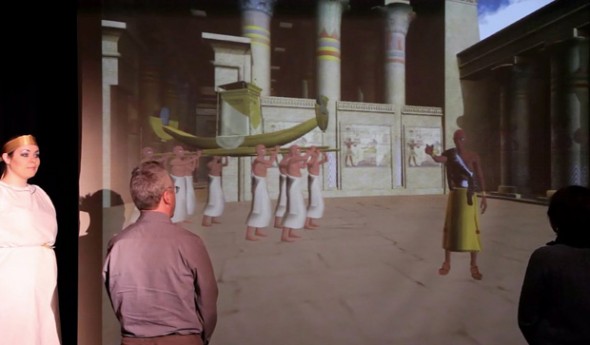
Two Northeastern University digital media students have made crucial contributions to an interactive virtual reality experience called “The Egyptian Oracle,” in which avatars, live actors and audience members reenact an authentic Egyptian ceremony.
Two Northeastern University College of Professional Studies digital media students have made crucial contributions to an interactive virtual-reality experience called “The Egyptian Oracle,” in which avatars, live actors and audience members reenact an authentic Egyptian ceremony.
The show will be performed in the Raytheon Amphitheater on Friday at 7 p.m.
Ajayan Nambiar, CPS’11, and Siddhesh Pandit, CPS’12, both of whom earned master’s degrees in digital media, completed theses on their contributions to the project. Nambiar designed the show’s surround-sound system, which utilizes the Doppler effect to enhance the environment’s sense of depth and realism. Pandit, for his part, redesigned the open-source game engine using the C Sharp programming language in order for actors to control avatars from remote locations.
Jeffrey Jacobson, director of PublicVR, a nonprofit dedicated to virtual reality research for education, conceived of the project and served as the students’ faculty adviser. The company received a $50,000 grant from the National Endowment for the Humanities to complete the prototype, employing a team of students and top professionals in several fields, and seeks another $400,000 to make the show bigger, better and more effective.
Jacobson praised the show’s educational value, noting that it has already been performed at the Axiom Gallery, an artists collective in Jamaica Plain, and for students at both the Jonas Clarke and William Diamond middle schools in Lexington, Mass.
“Egyptians loved their religious drama and theater, and that’s something that’s not often taught in schools or seen in museums or in movies,” he explained. “It’s very important because it’s the precursor to Greek and Western theater.”
Jacobson noted that the show produces a mixed reality, in which the real and virtual worlds collide to create new environments where both physical and digital objects co-exist. “It breaks the fourth wall, unlike ‘World of Warcraft’ or ‘Second Life,’ in which the player is outside of the virtual world,” he said.
Nambiar presented his thesis on sound design in June in Atlanta, Ga., at the 18th International Conference on Auditory Displays. The paper, he said, played a big role in his landing a job as a sound engineer for audio manufacturer Harmon Kardon.
“People were interested in my work,” he said. “They were impressed with the paper.”
Nambiar, who earned an undergraduate degree in computer science, noted that the project gave him the chance to combine the technical aspect of coding with the creative aspect of digital media. As he put it, “Until you’re actually working in this field, you don’t realize how seamlessly programming and media are connected.”
Pandit, who graduated in June, looks forward to breaking into the video-game industry with Activision or Electronic Arts. Working on “Oracle,” he said, gave him a glimpse of the field.
“I got exposure to a big industry,” he said. “I learned how much research goes into developing games.”